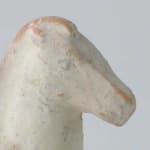Parthian Sculpture of a Horse and Rider, 100 CE - 500 CE
Terracotta
10.2 x 11.4 cm
4 x 4 1/2 in
4 x 4 1/2 in
PF.2945
Further images
After the death of Alexander the Great, his expansive empire was divided among three of his most loyal generals, with Seleucis assuming control of the eastern portion. The Seleucid Dynasty...
After the death of Alexander the Great, his expansive empire was divided among three of his most loyal generals, with Seleucis assuming control of the eastern portion. The Seleucid Dynasty was thereby established, following in the footsteps of the Persian, Assyrian, and Babylonian Empires, with its capitals at Antioch (in modern Syria) and Seleucia (in modern Iraq). However, as history has shown, maintaining calm and order over such a large territory, encompassing so many different cultures, proved difficult if not impossible. In 245 B.C., the Parthians revolted against the Seleucids under the leadership of Satrap Andragoras, igniting a civil war that would lead to further autonomy, despite the continued recognition of the Greek kings as their superiors. Although the Parthians had been mentioned in Assyrian text as early as the 7th Century B.C., it was not until the rise of Mithradates I that the yoke of Seleucid control was toss aside and Parthia reached the heights of its glory. Mithradates the Great quickly conquered the lands of Babylon, Media, and Elam, establishing a great empire that would rival Roman dominance and last until 224 A.D. when the Sassanid Empire finally subjugated their lands.
This lovely painted terra-cotta figurine depicts a regal looking horseman wearing a Parthian costume, his face adorned with a long, distinctive beard. He is mounted atop his trusty steed. Alas, the rider's face is somewhat more timeworn than that of his horse, whose right eye is still clearly defined by ancient pigment. Although this striking figurine is of Parthian origin, it was found in Israel and is indicative of a trade route between Israel and other parts of the Near East and Asia Minor. It is easy to imagine that the demand for well crafted imported art was just as great in ancient times as it today. This figurine clearly appealed to the ancient connoisseur of fine art as it does to the modern collector.
This lovely painted terra-cotta figurine depicts a regal looking horseman wearing a Parthian costume, his face adorned with a long, distinctive beard. He is mounted atop his trusty steed. Alas, the rider's face is somewhat more timeworn than that of his horse, whose right eye is still clearly defined by ancient pigment. Although this striking figurine is of Parthian origin, it was found in Israel and is indicative of a trade route between Israel and other parts of the Near East and Asia Minor. It is easy to imagine that the demand for well crafted imported art was just as great in ancient times as it today. This figurine clearly appealed to the ancient connoisseur of fine art as it does to the modern collector.









